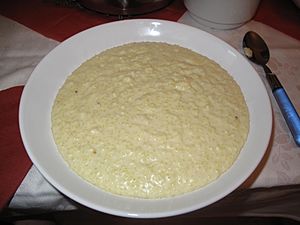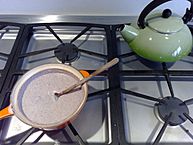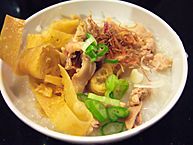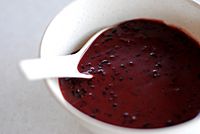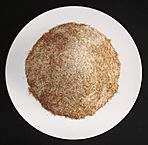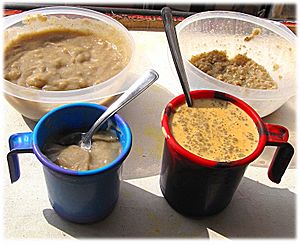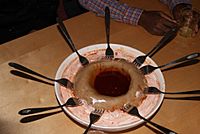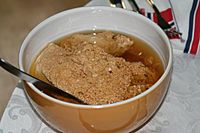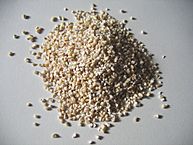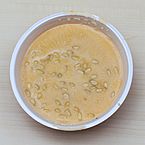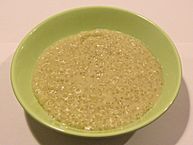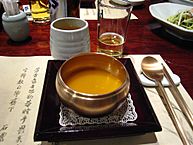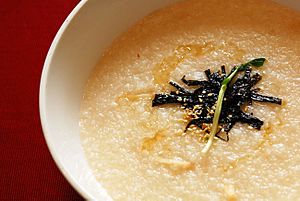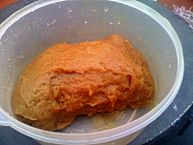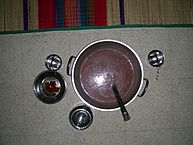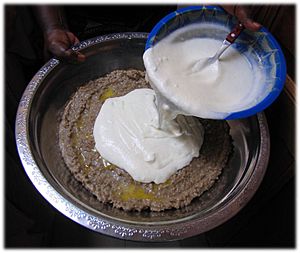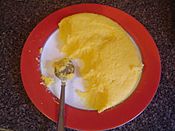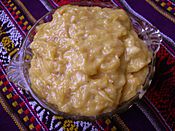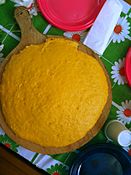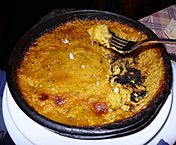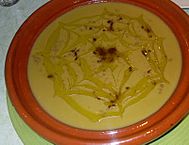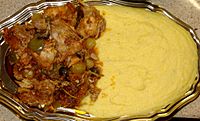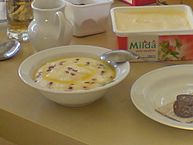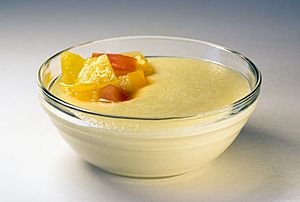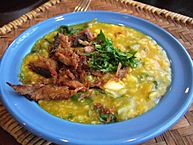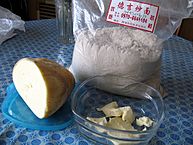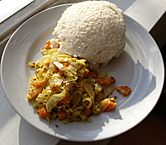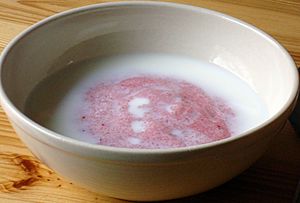List of porridges facts for kids
Porridge is a yummy and filling dish made by cooking grains or other starchy plants. You boil them in water or milk until they become soft and creamy. You can make porridge sweet with sugar and fruit, or savory with meat and spices. It's often served hot in a bowl and enjoyed all over the world!
| Top - 0-9 A B C D E F G H I J K L M N O P Q R S T U V W X Y Z |
Porridges from Around the World
A
- Atole – A warm, thick drink from Mexico and Central America. It's made from corn flour, water, unrefined cane sugar, cinnamon, and vanilla. Sometimes chocolate or fruit are added!
- Avena (drink) – This drink is made with cooked oatmeal, milk, water, cinnamon, cloves, and sugar.
- Arroz caldo or aroskaldo – A type of rice porridge from the Philippines.
B
- Barley gruel – A porridge from Danyang, China, made with barley, rice, and a special alkali ingredient.
- Belila – An Egyptian porridge made from pearl wheat. It's cooked in a light syrup with anise seed and golden raisins, then topped with nuts and milk.
- Bogobe jwa logala – A sorghum porridge from Botswana, cooked in boiling milk, with or without sugar.
- Brenntar – This porridge is popular in parts of Germany. It's made from a special roasted flour called Musmehl.
- Bubur ayam – A chicken rice porridge from Malaysia and Indonesia. It comes with shredded chicken and toppings like chopped scallions and fried shallots.
- Bubur kacang hijau – A sweet mung bean porridge from Malaysia and Indonesia. The beans are boiled in coconut milk with palm sugar.
- Bubur ketan hitam or bubur pulut hitam – A sweet dessert from Indonesia and Malaysia. It's a black glutinous rice porridge with coconut milk and palm sugar. People often call it "black rice pudding."
- Bygggrøt / -graut – A traditional Norwegian porridge made from barley, milk or water, salt, and butter. It's often topped with sugar, cinnamon, and a piece of butter.
-
Bubur ayam, with extra toppings
C
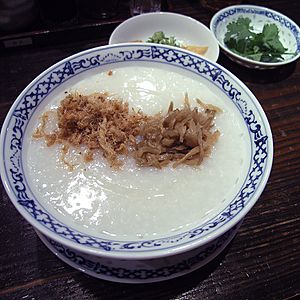
Chinese rice congee
- Cháo bầu – A Vietnamese rice porridge that includes pig kidney.
- Chatang – A traditional gruel (thin porridge) from Beijing and Tianjin, China. It's often sold as a street snack and can be made from different millet flours.
- Champorado or tsampurado – A sweet chocolate rice porridge from the Philippines.
- Congee – A popular rice porridge found in many Asian countries. It has many different names and ways of being made!
- Cream of Wheat – An American brand of farina, which is a porridge-like breakfast food made from wheat.
- Cuccìa – A traditional Sicilian dish with boiled wheat and sugar. It's eaten on December 13th, the feast day of Saint Lucy.
D
- Dakjuk – A type of juk (Korean porridge) made with chicken.
- Dalia – An Indian porridge made with Indian oats, often served with nuts and dried fruit.
E
- Eghajira – A sweet, thick drink enjoyed by the Tuareg people on special occasions.
F
- Farex A brand of instant baby cereal, served warm or cold as a first food for babies.
- Farina – A mild-tasting cereal food, usually served warm, made from grains like wheat.
- Frumenty A popular dish in medieval Europe. It was mainly made from boiled, cracked wheat. The name comes from the Latin word frumentum, meaning "grain."
- Fondé – A boiled porridge from Senegal, made with rolled millet flour pellets. It's served with condensed milk, sugar, and sometimes butter. It's for older children and adults.
G
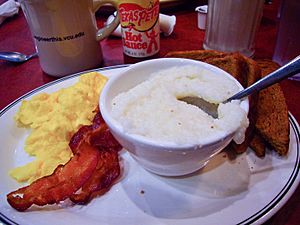
Prepared grits (in bowl)
- Ga'at – A thick porridge eaten in Eritrea and Ethiopia, often made with barley flour.
- Gachas An old, basic dish from central and southern Spain. Its main ingredients are flour, water, olive oil, garlic, and salt.
- Garbuzova kasha A traditional Ukrainian dish made from pumpkin, eaten for dinner or dessert.
- Gofio escaldado or escaldón A thick porridge from the Canary Islands. It's made by mixing gofio (a type of flour) with broth from a stew or soup.
- Gofio con leche A similar dish to the above, but made with hot milk and sometimes cinnamon. It's eaten for breakfast.
- Gomme (food) A traditional Norwegian dish, sometimes a white, porridge-like version made of milk and oat or rice grains.
- Grits A food made from ground corn, popular in the Southern United States, especially for breakfast. Modern grits are usually made from corn treated with alkali, called hominy.
- Groat (grain) – These are hulled kernels of grains like oat, wheat, and rye. They are whole grains, meaning they include the germ and bran.
- Gruel A very thin porridge, often thin enough to drink.
- Gungude Also known as congatay or plantain porridge, this Caribbean porridge is made from sun-dried plantains or green bananas. It's often given to babies.
- Guriev porridge A Russian porridge made from semolina and milk, with nuts (like hazelnut or almond), creamy foams (kaimak), and dried fruits.
-
Groats are often soaked before cooking to soften them.
H
- Hapanvelli – A traditional sour-tasting Finnish dish that looks a bit like pea soup.
- Harees – A Middle Eastern dish of boiled, cracked wheat and meat or chicken. It can be like a porridge or thicker, like a dumpling.
- Hasty pudding – A pudding or porridge of grains cooked in milk or water. In the United States, it's usually made from ground corn.
- Helmipuuro – A traditional porridge in Finland and Russia. It's made from potato starch grains that swell into clear "pearls" when boiled in milk, giving it the name "pearl porridge."
- Hobakjuk – A type of juk (Korean porridge) made with steamed pumpkin or squash and glutinous rice flour.
-
Hobakjuk served in a special bowl
J
- Janggukjuk – A Korean porridge made with pounded non-glutinous rice, beef, and shiitake mushrooms. It's seasoned with soy sauce.
- Jatjuk – A Korean porridge made by boiling finely ground pine nuts and rice flour.
- Jeonbokjuk – A juk made with abalone (a type of shellfish) and white rice.
- Juk (food) A popular Korean porridge made from grains like cooked rice, beans, and sesame. It's also eaten in other East Asian countries. Juk is often eaten warm, especially for breakfast.
K
- Kānga pirau A fermented corn porridge dish made by the Maori people of New Zealand.
- Kasha – A buckwheat cereal eaten in Central and Eastern Europe (especially Russia) and the United States. It's a common filling for a knish (a baked snack).
- Khichdi – A dish from Southeast Asia made by cooking lentils and rice together. It can be like a pilaf or more like a porridge or soup. It's a comfort food, often given to babies or sick people.
- Konkonte – A food from Ghana made from dried and pounded manioc root. It's also eaten in the Caribbean.
- Koozh – The Tamil name for a porridge made from millet. It's commonly sold by street vendors in Tamil Nadu, India.
- Krentjebrij – A traditional soup or porridge-like dessert from the Netherlands, made with berry juice. It can be eaten warm or cold.
- Kutia A sweet grain pudding, traditionally served in Russia, Ukraine, Belarus, and parts of Poland. It's often the first dish at the traditional Christmas Eve supper.
L

Laba congee with nuts and dried fruits
- Laba congee – A special congee dish eaten on the eighth day of the twelfth month in the Chinese calendar. It used to be made with red beans, but now has many different kinds.
- Lakh A very popular boiled porridge from West Africa (like Senegal). It's made with rolled millet flour pellets and usually topped with sweetened fermented milk.
- Lâpa A type of rice porridge or gruel eaten in countries that were once part of the Ottoman Empire.
- Lugaw or lugao – The Tagalog name for congee in the Philippines.
M
- Malt-O-Meal A porridge-like hot breakfast food.
- Mămăligă – A traditional dish from Romania and Moldova, made from yellow corn flour. It's similar to Italian polenta.
- Maypo – A brand of maple-flavored oatmeal from Vermont, USA.
- Mazamorra – A traditional corn-based food from Latin America. There are different versions in different countries.
- Mieum – A Korean gruel (thin porridge) made by grinding rice or millet into a powder and boiling it with water.
- Mingau – A Brazilian meal often made with cornstarch, sugar, and milk. It's often topped with cinnamon.
- Močnik – A traditional Slovenian porridge.
- Mush A thick cornmeal pudding or porridge, usually boiled in water or milk. It's often left to set, then cut into pieces and fried.
O
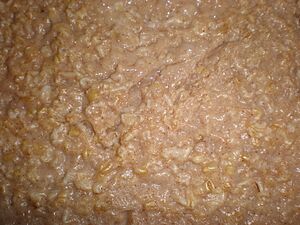
A close-up of cooked oatmeal
- Oatmeal – Also known as white oats, this is ground oat grains, or a porridge made from oats. Oatmeal can be ground, steel-cut, crushed, or rolled oats.
- Obusuma The Luhya word for Ugali, a Kenyan dish also called sima or posho. It's made from corn flour cooked with boiling water until it's a thick, dough-like porridge.
- Ogokbap – Or five-grains rice, a Korean food made of steamed rice mixed with grains like barley, foxtail millet, and soybeans.
- Okayu The Japanese name for a type of congee. It's less broken down than other congees and is often seasoned with salt, egg, salmon, ginger, and pickled plums. It's commonly served to babies, the elderly, and sick people.
- Øllebrød – A traditional Danish dish, a type of porridge made from leftover rye bread and beer. It's a clever way to use up old bread!
P

Papeda, served in Jakarta, Indonesia
- Pap Also known as mieliepap in South Africa, this is a traditional porridge/polenta made from ground corn. It's a main food for many people in South Africa.
- Papeda – Or bubur sagu, a sago flour congee that is a main food for native people in parts of Indonesia.
- Pastel de choclo – A dish based on sweetcorn, popular in Chile, Argentina, Bolivia, and Peru.
- Pease pudding – A savory pudding from Britain made from boiled split yellow peas, water, salt, and spices. It's often cooked with bacon.
- Pinole – A coarse flour from ground toasted corn kernels, often mixed with herbs and seeds. It can be eaten by itself or used to make a drink.
- Pirón or Pirão – A gummy porridge made from cassava starch and broth, eaten in Argentina, Uruguay, and Brazil.
- Poleá – A sweet Andalusian porridge from Spain, made with flour, milk, and sugar, and flavored with anise. It's often served cold with fried bread croutons.
- Polenta – Cornmeal boiled into a porridge. It can be eaten as is, or baked, fried, or grilled. The name comes from Latin for "hulled and crushed grain."
- Puliszka A coarse cornmeal porridge in Hungary, especially in Transylvania. It's traditionally made with sweetened milk, goat's milk cottage cheese, bacon, or mushrooms.
-
Polenta (right), with rabbit
R
- Red River Cereal – A porridge from Canada made of cracked wheat, rye, and flax seed. It's boiled in water and usually served with milk and brown sugar.
- Rice cereal – The common name for baby food made from rice.
- Riebel – A porridge dish from Austria made with cornmeal, butter, milk, and salt.
- Rødgrød – A sweet fruit dish from Denmark and Germany. It's like a pudding, often using potato starch to make it creamy.
- Rømmegrøt – A Norwegian porridge made with sour cream, whole milk, wheat flour, butter, sugar, and salt.
- Rubaboo – A basic stew or porridge eaten by fur traders and Métis people in North America. It was traditionally made of peas or corn with animal fat and a thickener like bread or flour.
- Rouy A smooth, boiled millet flour porridge from Senegal, made just with water and sifted millet flour. It's often the first solid food given to babies.
-
Rømmegrøt, topped with butter
S
- Sadza – A cooked cornmeal dish that is a main food in Zimbabwe and other parts of Southern and Eastern Africa.
- Semolina pudding – Made from semolina (a type of wheat grain), cooked with milk or a mix of milk and water. It's often served with sugar, cocoa powder, cinnamon, raisins, fruit, or syrup.
- Sofkey A traditional Native American porridge from the southeastern US. It's made from corn, boiled in water with lye. It can be eaten hot or cold, with or without seasoning.
- Sowans – A Scottish dish made using the starch left on oat husks after milling. The husks are soaked and fermented, then the starchy part is boiled with water and salt.
- Stip (dish) – A regional dish in the Dutch provinces of Groningen, Drenthe, and Overijssel. It's a buckwheat porridge with a hole in the middle for fried bacon and syrup.
T
- Talbina An Arabian porridge made with barley flour and water or milk. Honey or dates are added for sweetness.
- Tapioca pudding A dessert made of tapioca (small starch balls), fruit juice, milk or water, and sugar.
- Taragna A type of polenta (Italian cornmeal) made with buckwheat. It's a traditional dish from the Italian Alps.
- Tarakjuk – A Korean porridge made by boiling milk and finely ground rice.
- Tinutuan – A rice porridge from North Sulawesi, Indonesia. It's mixed with various vegetables like spinach, corn, pumpkin, and sweet potato.
- Tsampa – A main food in Tibet, especially in the central region. It's roasted flour, usually barley flour, sometimes with wheat flour.
- Tsampurado – A sweet chocolate rice porridge from the Philippines, often eaten with milk and dried salted fish.
-
Tinutuan, with salted fish
U
- Ugali – Corn flour cooked with water to a porridge or dough-like texture. This dish is common in East and Southern Africa.
- Upma – A common breakfast dish from South India and Sri Lanka. It's a thick porridge made from dry roasted semolina, often with seasonings and vegetables.
- Uji (porridge) – A porridge from East and Southern Africa, made from maize, sorghum, or millet flour cooked with water. The word "uji" is Swahili.
V
- Vispipuuro – A sweet, wheat semolina dessert porridge made with berries, usually lingonberries. It's eaten in Sweden, Finland, and Estonia.
W
- Wheatena – An American high-fiber, toasted-wheat cereal. It started in New York City around 1879 when a bakery owner began roasting and grinding whole wheat for sale.

All content from Kiddle encyclopedia articles (including the article images and facts) can be freely used under Attribution-ShareAlike license, unless stated otherwise. Cite this article:
List of porridges Facts for Kids. Kiddle Encyclopedia.

